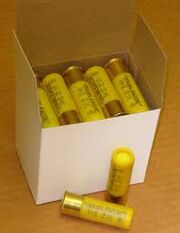
A box of 20 gauge shells.
The 20 gauge cartridge is a shotgun cartridge. It is smaller in caliber (.615) than a 12 gauge (.729). Although the 20 gauge is far thinner and shorter than a 12 gauge, it can most commonly be distinguished by its common yellow plastic wrapping.
History[]
Uses[]
The 20-gauge cartridge is sometimes considered more suitable for hunting certain types of game because it damages less tissue, which makes it suitable for most game birds. It is especially suitable for hunting game birds such as quail, grouse, turkey, and other small game when using shot shells. 20-gauge cartridges also come as slugs and can be an effective deer hunting cartridge.
Many sport shooters will participate with the 20 gauge at sporting events such as skeet and trap tournaments. The 20 gauge shell is the only shell with a mandated color, which is yellow. This is done in order to make 16ga shells and 20ga shells easily distinguishable and to reduce the risk of damaging the firearm or unintentionally harming another individual. In addition, 20-gauge shotguns can often have less recoil than 10, 12 or 16-gauge versions on average, and may be more desirable to those who want to experience less recoil for prolonged shooting.
The lower recoil also makes a 20-gauge appropriate for younger (or conversely, elderly) shooters who may have a difficult time firing a larger shotgun. However, recoil is largely dependent on the weight of the gun itself; for instance, a 4.5 pound 20 gauge can have more recoil than an 8 pound 12 gauge. This is widely considered a flaw in the design of so called 'youth' guns.
Design details[]
It takes 20 lead balls of the diameter of a 20-gauge shotgun bore to amount to 1 pound, while it only takes 12 lead balls of the diameter of a 12 gauge shotgun bore to equal the same amount. 20-gauge cartridges, like the 12 gauge, also come as slugs.
20-gauge shotguns loaded with slugs are usually less accurate than rifles, but they often have better terminal ballistics at close range due to the size of the projectile; however, this depends on the amount of gun powder in the shell's load.